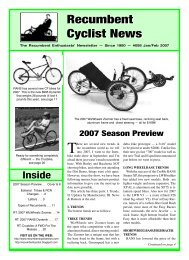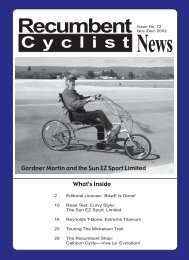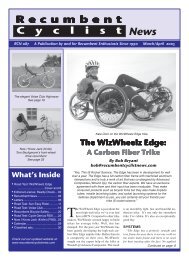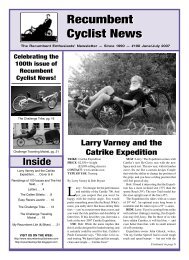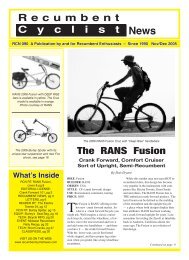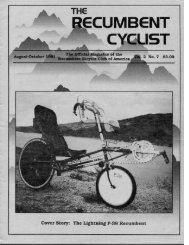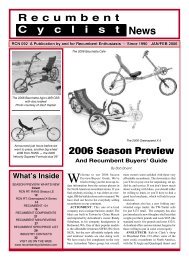Recumbent News
Recumbent News
Recumbent News
Create successful ePaper yourself
Turn your PDF publications into a flip-book with our unique Google optimized e-Paper software.
Note Penninger jackshaft and two rear derailleurs<br />
accustomed to the steering-arm control,<br />
but I would recommend that new riders<br />
take a few minutes of maneuvering<br />
through an open area to get the feel of it<br />
before trying it in a tight or congested area.<br />
The highly responsive steering, however,<br />
is something of a double-edged<br />
sword. While a bicycle tends to feel more<br />
stable the faster you go, and the gyroscopic<br />
action of the front wheel tends to resist<br />
any radical steering moves at higher<br />
speeds, the steering of the Voyager will<br />
respond to the steering arms quite readily<br />
even at higher speeds. A small amount of<br />
pressure on the steering arms can result in<br />
a turn, and this lends a certain twitchy feel<br />
to the steering. While riding the Voyager<br />
at speeds between 15 and 20 mph, I wondered<br />
if anyone had considered adding<br />
caster action to the front wheel, similar to<br />
how they adjust the front-end alignment<br />
of cars. By making the hub of the front<br />
wheel slightly trail the pivot point of the<br />
steering, the steering will tend to naturally<br />
track a straight line. Perhaps the design<br />
engineers have a reason for not doing this<br />
on the trikes, but it did occur to me as I<br />
was riding. That said, though, I must also<br />
comment that I had no problem whatsoever<br />
keeping the Voyager on track and in<br />
my lane, even at speeds up to 25 mph.<br />
Momentarily releasing both steering arms<br />
at any speed, though, resulted in drift very<br />
quickly. Likewise, since only the left rear<br />
wheel is driven, there is a slight tendency<br />
for the trike to want to steer to the right<br />
under heavy pedaling. This is not sufficiently<br />
evident to create a problem, and<br />
it’s only noticeable when the hold on the<br />
controls is too relaxed, but it bears remembering<br />
that the physics of the trike requires<br />
consistent attention to the steering. Heavy<br />
braking on only one or the other of the<br />
rear wheels will also cause the trike to tend<br />
10 <strong>Recumbent</strong> Cyclist <strong>News</strong> 71<br />
to pull to one side, but again, this effect is<br />
minimized by the length of the trike and<br />
the leverage the steering maintains accordingly.<br />
In the unlikely event that one brake<br />
fails, the trike would still be able to be<br />
safely stopped using the other brake, albeit<br />
in a bit longer distance. A note here<br />
on the braking: the Voyager comes with<br />
stock Shimano brake pads, which do not<br />
offer the best braking power. Frank at Ajo<br />
Bikes swapped these out for better brake<br />
pads after my initial spin on the trike<br />
(which he normally does before selling the<br />
trike). The beefier brake pads gave a much<br />
more satisfying feel of braking power over<br />
the stock pads, and I immediately understood<br />
why Frank routinely replaces them.<br />
Another surprising factor on the Voyager<br />
is that at no time during the test ride<br />
did it ever feel as though I was pedaling a<br />
50-pound vehicle. Despite its weight, the<br />
Voyager rolls smoothly and accelerates<br />
well. The twin 8-speed cassettes, augmented<br />
by a double chainring up front (a<br />
52/39 combo), offers the amazing total of<br />
128 different gear combinations.<br />
Penninger advertises that the gear-inches<br />
on the Voyager range from 16 to 85. To<br />
check how well the Voyager starts up<br />
against a hill, I stopped at the bottom of a<br />
short but somewhat steep underpass. In<br />
the lowest gear combination of the twin<br />
cassettes, but still in the 52-tooth<br />
chainring, I started climbing almost effortlessly.<br />
It took me a moment, though, to<br />
realize that I was actually slightly lifting<br />
the front wheel with the torque I was applying<br />
through the low gearing. Please<br />
note on this that I had the seat positioned<br />
all the way back, placing it almost directly<br />
over the rear axle and distributing my<br />
weight predominantly back. Once I noticed<br />
the wheelie effect, I backed off on<br />
my pedaling effort slightly to maintain<br />
Voyager drivetrain<br />
The Voyager<br />
Voyager in Toyota pickup<br />
contact with the front tire. The chainrings<br />
do not have a derailleur, though, and must<br />
be shifted by hand. With practice I’m sure<br />
a person could do this while riding, but<br />
my attempt to do so merely resulted in a<br />
jumped chain.<br />
While it might have been this trike’s<br />
novelty to a certain extent, I have to say<br />
that the Voyager was fun to ride. The learning<br />
curve was fairly short, and I would<br />
venture that nearly anyone would be able<br />
to get on one and go out and enjoy it<br />
quickly. My 18-year-old son took it for a<br />
test spin and wondered how long it would<br />
take him to be able to afford one.<br />
Owning<br />
The Voyager seems well suited for tour-



